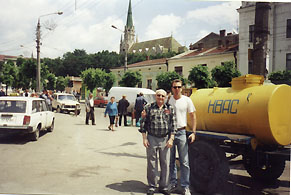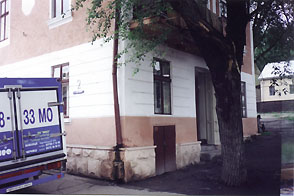SADAGURA
MY PLACE OF BIRTH
BY:- NATAN WEISSMANN
EDITED BY:- RAFIE WEISSMANN
ENGLISH BY:- MILTON BRYAN (FATHER-IN-LAW OF DROR, THE SON OF NATAN)
(to contact the author, write to Dror Weissmann)
After 60 years, I finally decided to visit the place of my birth. I guess it was curiosity and desire to show my youngest son the roots of his family that prompted this journey.
I, Natan Weissmann now 75 years old, was born in Sadagura, Bukowina (now Ukraine) in 1926. I speak German, Yiddish, Romanian, Russian, Ukrainian, Hebrew and English.
 My
son Rafie, 26 years old, who accompanied me on the trip is a native born Israeli
and speaks Hebrew and English.
My
son Rafie, 26 years old, who accompanied me on the trip is a native born Israeli
and speaks Hebrew and English.
We took a direct flight to Bucharest from Tel Aviv, arriving in the evening and spent the night in a Bucharest hotel. Our visas to enter Ukraine, which are required for Israeli citizens, were secured in Israel at the Ukrainian embassy at the exorbitant price of 170$ each. The trip took place in June 2001.
We bought our train tickets (30$ one way) in advance on the day we arrived. The next day we took a taxi to the train station, arriving early for the 7:30 o'clock, once daily, departure to Czernowitz. It's a train that starts out in Sofia, Bulgaria picks up in Bucharest, Romania has a stop at Czernowitz, Ukraine and finally terminates in Moscow, Russia.
In the station there was a sign announcing a 45 minute delay .The taxi driver suggested that we shouldn't linger around the station because of pick pockets etc. We had something to eat. As the sign hadn't changed, we inquired and were shocked to be informed that the train had already left.
Now began an uninvited adventure. Seeing our predicament, another taxi driver volunteered taking us to the border close to Kisnev and from Kisnev we could take a bus to Czernowitz.
It was a six hours drive to the Moldovia border crossing. Even after bickering, we had to pay the driver 80$. It cost another 30$ each to get visas in order to pass through Moldovia. At the crossing there was a mini bus waiting. It cost 5$ each to drive the 2.5 hours to Kisnev.
The Kisnev to Czernowitz bus is a modern bus, which makes the trip once or twice a day. It only cost 6$ and is an eight hour trip. We had to wait four hours for the bus that left at 23:00 bus and arrived in Czernowitz at 7:00 o'clock the next morning. From the bus station it was a five minute taxi drive to the Chermosh Hotel. We checked in and immediately took a taxi to Sadagura.
I had no trouble communicating in Czernowitz and Sadagura as I speak Russian and its sister tongue, Ukrainian.
On the way to Sadagura, the taxi driver stopped and pointed out the former Sadagura rebbe’s center. It was a large complex consisting of three main buildings. The center was abandoned when the rebbe moved his Hassidic dynasty to Czernowitz in 1914. This Hassidic movement now also has a center close to Tel Aviv. Between 1914 and 1941 the Sadagura complex was used a charitable center for destitute Jews. Now it is a ruin.
As we approached Sadagura I started to recognize the area and was able to direct the driver exactly to our family home (Peremogi Street 2).
Our driver was very helpful. He remained with us during our stay in Sadagura and then drove us back to our hotel. I paid him15 dollars for the days work, which he willfully accepted. Generally payments were made in dollars or local currency.
Exteriorly the house is as it was when I left it at the age of 14. For me Sadagura and this home are my roots. I can't remember my parents talking about a family tree reaching back any further than Sadagura. After Sadagura, my family was reborn in Israel.
The ground floor was the family's restaurant and the upper floor was the family living area. Besides myself, the family consisted of mother, father and a six year younger brother. Now the ground floor is a children’s library and the upper floor is divided into two apartments.
 The
librarian told me that her mother mentioned that the library once was a café!!
Being inside the house, memories flashed back, awakening emotions. I felt
dizzy and asked the librarian for a drink of water. She directed me to the
outdoor well shed!! Outside, nothing had physically, basically changed in
60 years. Here was the well and bucket and near by the outhouse. There was
no plumbing with running water and no sewage. To properly bath you had to
go to a bathhouse, just as we did 60 years ago. I remember we had electricity
then, so that wasn't new. On the positive side, I can say there are now less
horse drawn wagons than back then.
The
librarian told me that her mother mentioned that the library once was a café!!
Being inside the house, memories flashed back, awakening emotions. I felt
dizzy and asked the librarian for a drink of water. She directed me to the
outdoor well shed!! Outside, nothing had physically, basically changed in
60 years. Here was the well and bucket and near by the outhouse. There was
no plumbing with running water and no sewage. To properly bath you had to
go to a bathhouse, just as we did 60 years ago. I remember we had electricity
then, so that wasn't new. On the positive side, I can say there are now less
horse drawn wagons than back then.
Sadagura was a quiet shtetl village (80% Jewish). We were a traditional family and not Hassidic or orthodox as most of Sadagura Jews. I attended a Romanian government school where lessons were conducted in Romanian and in the afternoon attended header, where I studied Hebrew, basically for my bar mitzvah, which was held at one of the local synagogues.
As we ran the restaurant we had contact with gentiles. Thus as a child I had a knowledge of the other world, even though I never traveled much out of the Czernowitz area. I enjoyed my childhood and hadn't had many anti-Semitic encounters.
In 1940 the Russians occupied and took over Sadagura from the Romanian authorities. As we owned a restaurant we were considered capitalist. The Russians confiscated all the premises and we were evicted. We now were without home, restaurant and income. We found a place to rent. Our black days had already started a year before the Transnistria deportation.
In less than a year the Romanians retook the area, accused the Jews of being communists and decreed that they would be deported. One-week notice was given and everyone was deported on the same day from the train stop at Sadagura. We weren't restricted to what we could take. The catch was that the train trip terminated at Marculesti and the long three week trek to the villages was by foot. We couldn't manage carrying our belongings and thus had to be abandoned almost everything along the way. We ended up in a vacated village called Bershad. These were the years of starvation, the death of my father, the heroic carrying on of mother, the loss of my legs to frost bite and the great braveness of my younger brother. The details of " from Bershad to Israel " could be written up as another story or even a book.
The next day we came back to Sadagura with the same driver. While filming other former family homes, I was approached by a local who volunteered to take us to the former Sadagura synagogue. It's now some type of knitting factory. We weren't allowed admission. Exteriorly there's no sign that it formerly was a synagogue. Inquisitively people gathered and we conversed. One person who was born in 1934 claimed that he remembered families that I had on my checklist. He related to me incidents that had taken place, that only a local would have known. He claimed he was the shabass goy for the community. On the way back to Sadagura we stopped at the train stop from which the deportation took place.
The whole trip has been video filmed, thanks to my son. He interviewed me on site along with others with whom I was conversing. The video is a wonderful record of our trip. By mistake a role of 35mm film was double exposed and thus we lost half of our still photos.
Back in Czernowitz we went to the local archives where all of Sadagura records are held. As I do not have any documents, my intent was to get a copy of my birth certificate. I was promised it would be searched, but to date, after several reminders, I still haven't received it.
The next day, we took the train back to Bucharest. It's the same train that we missed in the beginning of this story, but this time going in the Sofia direction. The coaches were old, the window locked, and the train did have a service coach. The trip took twelve hours. These twelve hours included four hours at the border where the trains' cars chassis had to be changed from the Russian gauge to the European standard and the custom agent counting all my declared money.
From Bucharest we flew back to Israel ending a very rewarding trip.
